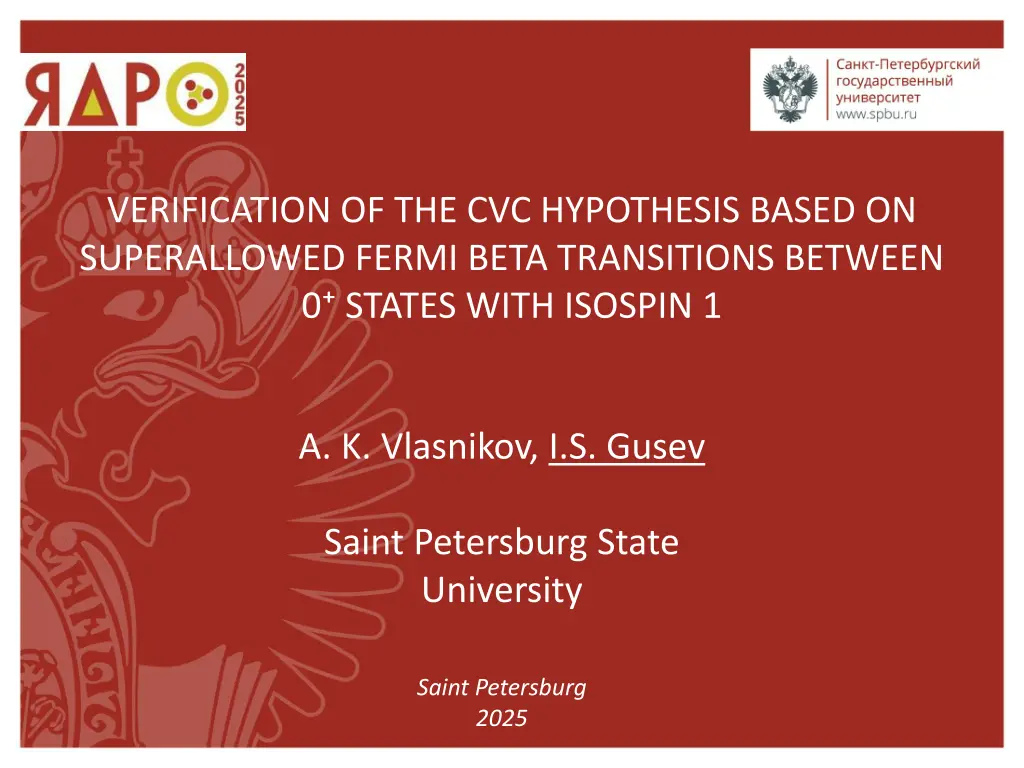
Verification of CVC Hypothesis in Superallowed Fermi Beta Transitions
In this study, the CVC hypothesis is evaluated based on superallowed Fermi beta transitions between 0 states with isospin 1A. The objective is to test the constancy of Ft values for the considered transitions, compare with literature data, and evaluate the vector coupling constant GV. The methodology includes analysis of theoretical corrections and formation of input data set for evaluation.
Download Presentation

Please find below an Image/Link to download the presentation.
The content on the website is provided AS IS for your information and personal use only. It may not be sold, licensed, or shared on other websites without obtaining consent from the author. If you encounter any issues during the download, it is possible that the publisher has removed the file from their server.
You are allowed to download the files provided on this website for personal or commercial use, subject to the condition that they are used lawfully. All files are the property of their respective owners.
The content on the website is provided AS IS for your information and personal use only. It may not be sold, licensed, or shared on other websites without obtaining consent from the author.
E N D
Presentation Transcript
VERIFICATION OF THE CVC HYPOTHESIS BASED ON SUPERALLOWED FERMI BETA TRANSITIONS BETWEEN 0 STATES WITH ISOSPIN 1 A. K. Vlasnikov, I.S. Gusev Saint Petersburg State University Saint Petersburg 2025
INTRODUCTION Objective of the Study: To test the CVC hypothesis Tasks: 1) Apply the methodology certified by the state corporation "Rosatom" for evaluation of half-lives and branching ratios for 15 superallowed 0 0 beta decays; Verify the constancy (within uncertainties) of the Ft values for the considered transitions, as predicted by the conserved vector current (CVC) hypothesis; Obtain the evaluated average Ft value for all considered transitions and compare it with available literature data. Evaluate the vector coupling constant GV and the CKM matrix element ??? 2) 3) 4) 2
OBJECTIVE OF THE STUDY CVC hypothesis: ? ?? = 2 = const ??2?? Taking into account theoretical corrections: ? ??0+ 0+= ?? 1 + ? 1 + ??? ?? = ?= const 21 + ? 2?? where ?is the part of the radiative correction that is independent of nuclear structure and depends only on the nuclear charge ? and the electron energy, ???is the radiative correction that depends on the underlying nuclear structure, ??is the correction for isospin symmetry breaking, ? same for all beta decays. ?is the radiative correction that is the 3
OBJECTIVE OF THE STUDY Partial half-life of the considered decay branch where t is the partial half-life of the transition, ?1/2 is the total half-life, ???and ??+ are the probabilities of electron capture and decay, BR is the branching ratio. 4
RELEVANCE Evolution of the average ??0+ 0+performed by Hardy and Towner. 5
METHODOLOGY Formation of the Input Data Set: 1. Selection of published independent results; 2. Possible adjustment of results 3. Identification of statistical outliers (Chauvenet s criterion)
METHODOLOGY For the unweighted average: For the weighted average: 7
METHODOLOGY In the updated methodology, the selection of the recommended value is performed as follows:
RESULTS AND DISCUSSION Half-life evaluation ?1/2 9
RESULTS AND DISCUSSION Branching ratio evaluation ?? 10
RESULTS AND DISCUSSION Branching ratio evaluation ?? 11
RESULTS AND DISCUSSION Calculated Ft values 12
RESULTS AND DISCUSSION The total uncertainty in the final Ft value includes contributions from both statistical and systematic errors. The latter originates from uncertainties in the theoretical calculations of ?? uncertainties are accounted for, the calculations yield the final value: (0.36 ) and ???(1.73 ). When these ?? = 3072.3 2.1 The work by Hardy and Towner yields the value ?? = 3072.24 1.85 . Using the evaluated mean Ft-value, we calculate ??: ?? ( ?)3= 1.1357 4 10 5 ??? 2 14
RESULTS AND DISCUSSION We determine Vud using the formula: ?? ?? ??? = where ?? is the well-known weak interaction constant from muon decay. The calculation yields: Vud = 0.97371(34) The work by Hardy and Towner yields Vud = 0.97373(31) 15
CONCLUSION Key Results: 1) Evaluations of half-life periods and branching ratios have been performed based on the methodology certified by the state corporation "Rosatom" for 15 superallowed 0+ 0+ beta-decays; 2) Based on the evaluated values of ?1/2 and ??, the Ft- values have been calculated. The obtained results do not contradict the CVC hypothesis; 3) An evaluated Ft-value, averaged over all considered transitions, has been obtained; 4) An estimation of the vector coupling constant GV and the CKM matrix element ???has been performed. 16
Thank you for your attention! - spbu.ru
REFERENCES Hardy J. C., Towner I. S. Superallowed nuclear decays: 2020 critical survey, with implications for and CKM unitarity // Phys. Rev. C. 2020. V. 102, Art.N0.045501. Kuzmenko, N. K. Current status of the recommended half- lives for theradionuclides used as the standards of photon emitters // Appl. Radiat. Isot.2022. V. 180, Art.N0. 110039.






















